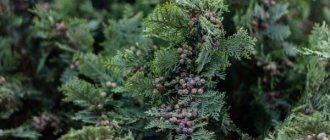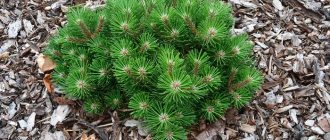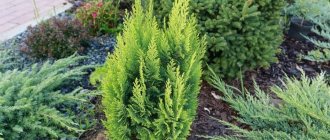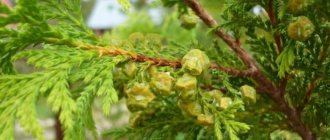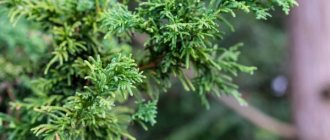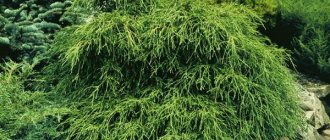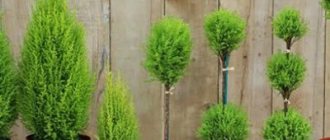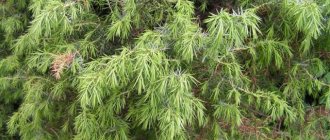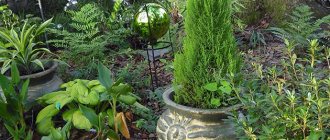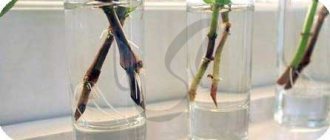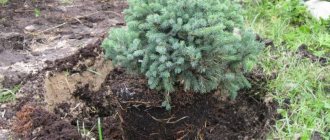Description of the features of Elwoodi cypress
Lawson Elwoodi cypress originally grew on the mountain slopes of North America and in the eastern part of Asia.
- It is an evergreen tree reaching a height of approximately 3.5 m.
- The tree's growth per year is about 5 (in rare cases 10) cm. Growth is slow, like the Canadian conika spruce, so you need to be patient to grow an adult plant.
- Even at the age of 10 years, the height of the plant will not exceed one and a half meters.
- As can be seen in the photo, the crown is shaped like a wide cone with a diameter of 1-1.2 m with vertical, tightly closed shoots.
- Young trees have needle-like leaves, which distinguishes Elwoodi cypress from other conifers.
- You can buy cypress either in a garden store or on the Internet. The price depends on the age and growth of the plant. The cost of 80 cm of Elwoodi seedling is 350 rubles.
Description of the plant
Ephedra Elwoodi is an evergreen garden variety of Lawson's cypress from the subclass of coniferous gymnosperms. Individual specimens of the family tree grow up to 70 m in length with a trunk 5 m in diameter.
The crown is formed by flexible branches growing strictly upward, forming a cone shape. Base size up to 1 m.
The color of the uniformly colored needles occurs in shades of green, gray and dove-blue, sometimes with a metallic tint.
The structure of the foliage is needle-like, scaly, and after some time it gathers into a diamond-shaped leaf plate with a blunt tip.
Caring for Elwoodi cypress at home
Caring for Elwoodi cypress at home is quite simple, so even novice gardeners can safely start the plant.
- Location. Slightly shaded areas are more suitable for the tree. In the summer heat, the crown must be sprayed, but the soil should not be allowed to become waterlogged.
- Lighting. You should choose shady areas for placement. The plant reacts negatively to direct rays of the sun, and as a result of their exposure, burns may appear on the leaves. The best place for a pot is a window facing north, or a glazed loggia with protective windows. Pitch darkness should not be allowed, otherwise the needles may change color.
Important! When it gets colder, the tree prefers diffused light.
- The temperature is better reduced. In summer, no higher than 15 degrees, and in winter, no lower than 10.
- Humidity should also be high. The plant does not like dry and hot places. At home, he reacts poorly to the inclusion and active operation of heating devices, or to their close placement. That is why in winter the pot should be removed away from the radiator, and in summer it should be placed in a shaded area in the garden.
- Watering. The tree loves water. In summer and spring it needs frequent watering so that the substrate does not dry out. But an excessive amount of water can negatively affect the condition of the plant, so it is better to use moderation when watering. During autumn and winter, watering should be reduced; it should be done only when the top layer of soil is dry.
Interesting! The cypress tree responds very well to this trick: freeze the water, then place ice cubes around the tree. This will help moisten the soil and air.
- Feeding. The period for applying fertilizers is from late spring to mid-October, once every 14 days. In winter it is better not to feed.
Important! The dose of fertilizers should be halved from the volumes indicated on the packaging.
- Trimming. It is better to start pruning old and dry branches in March. At the same time, you can also issue a crown. Often it is given the appearance of an elongated cone. At one time, you can remove no more than 1/3 of the total mass of foliage. Bare branches should not be left, because they will soon dry out. Perform pruning only a year after planting.
- Priming. Elwood prefers well-drained, loose soil, so when planting it should not be deepened too much, as this can lead to the death of the tree. The soil should consist of peat, turf, sand and leaf soil (1/1/1/2).
Resistance to diseases and pests
Good care will keep your plants healthy
The cypress species is quite resistant to diseases and pests, however, failure to comply with primary preventive measures and improper care can lead to the appearance of parasitic insects and plant diseases.
Pests
More often, the cypress family is susceptible to attack by scale insects and spider mites. Treatment with insecticidal preparations, for example, Aktara, Aktellik, Karbofos and the like, helps to cure the affected conifer.
Diseases
Excessive watering causes root rot. With a lack of moisture and drying out of the soil and air, cypress needles begin to turn yellow, dry out and crumble.
Basic preventive measures:
- dosed watering for potted conifers;
- carrying out spraying;
- creating shade during hot periods.
Reproduction of Elwoodi cypress
Plant propagation occurs in the following ways:
- seeds;
- bends;
- cuttings.
In the first case, wild crops are taken. The germination of such seeds lasts about 15 years. Seeds are planted in winter according to the following scheme:
- Before planting, the seeds undergo a growth-accelerating stratification procedure.
- They are planted in containers with loosened soil, and taken outside, covered with a layer of snow and left until spring.
- In the spring, the containers are brought into the warm place and warmed up until shoots appear. Young growth is systematically watered and replanted if necessary.
- When it gets warm, the pots are taken out to fresh air in places without drafts.
The cutting method is as follows:
Cuttings are taken from side shoots at the beginning of spring, no more than 15 cm long. Leaves are removed from the lower part and planted in soil made of equal parts of perlite, sand and small impurities of pine bark. The young animals are covered with film for 2 months.
The tapping method is suitable for creeping, weeping varieties growing outdoors in open ground.
Reproduction
Elwoodi cypress can be easily propagated on your own. The easiest way is vegetative. Propagating conifers from seeds is time consuming and troublesome, but the resulting plants live longer, are better adapted to local conditions, and are generally healthier than those grown from cuttings or layerings.
At the beginning of summer, the tops of strong shoots are cut and the lower needles are removed. Then the cuttings are planted in perlite or a mixture of peat and sand, treating the cut with root or heteroauxin. Place under film or a plastic bottle cut off from the bottom. Regularly water, spray, and ventilate. When new shoots appear, the shelter is removed. Next spring they are transferred to the school.
Low-lying branches can be buried in the spring to create a new plant. For this:
- part of the shoot, which will be covered with soil, is freed from needles;
- make a cut in the middle and insert a match into it;
- the wound surface is treated with a root formation stimulator, for example, heteroauxin;
- secure the shoot with metal staples;
- sprinkle with soil;
- after a year they are planted in a permanent place.
Cypress grown from seeds may not inherit varietal characteristics; moreover, special conditions must be created for the seedlings - these are not flowers or seedlings. They are looked after for 2-3 years, processed, and culled. At home, it is difficult for a non-specialist to do everything correctly, and it is difficult to bring conifers grown from seeds to planting in a permanent place.
How to transplant a cypress tree
If you are interested in how to care for the Elwoodi cypress, then you must study the transplantation technology, since it is extremely painful to tolerate this procedure due to its delicate root system. This manipulation should be carried out only in extreme cases, choosing a pot a couple of centimeters larger.
Here are the transplant instructions:
- Take a slightly larger pot.
- Carefully transfer the tree from the old container to the new one, without disturbing the earthen coma.
- Do not deepen the root neck too much, so as not to destroy the plant.
- Place Elwoodi in the shade, reduce watering and resume only after the painful period has passed.
- Remember that cypress prefers fertile, loose and draining soil.
Care
The Elwoodi cypress is quite capricious; you need to care for it, carefully following all the rules. All varieties are delicate, require attention, and lose their decorative appearance without proper care. And in order to restore a withered conifer, you will have to spend more than one year.
Watering
Cypress loves moisture, but in moderation. You should not allow the top soil layer to dry out, but you should not create a swamp around the trunk either.
When growing in the garden, pour 10 liters of water at a time under the bush. Watering is carried out every 3 - 5 days (frequency depends on the weather). On hot days, it is useful to spray both at home and in the garden.
Feeding
It is advisable to buy fertilizers in the store
Decorative conifers respond well to feeding - they are used from the end of March to the end of September.
They buy only special complex preparations for home conifers and bonsai. For conifers growing at home and not in the garden, the dosage is reduced by half. Feeding is carried out once a month.
The table lists commonly used fertilizers and describes the features of their use.
| "Needle" | 5 g dissolved in a bucket of water (5 l), used every 2 weeks |
| "Aquarin coniferous" | 20-30 g are dissolved in a bucket of water (10 l), consumption for a young bush - 5 l, for an adult - 10-30 l, applied 3 times during the growing season with an interval of 15-20 days |
| "Hera coniferous" | 20-30 g per barrel. 2 times per growing season |
| "Pokon" | 40 g per bush, or 60 g per 1 m2 |
A good option is alternating root and foliar feeding. To maintain the richness of the color and the splendor of the crown, you should spray the ephedra with boron, zinc, and magnesium solutions. You can purchase medications in a specialized store.
Since the root system is superficial, fertilizer is applied only after the seedling is watered. In dry soil, fertilizing can burn the roots.
In winter, food is not used.
Mulching and loosening the soil
Mulching is used to preserve soil moisture. Peat, bark, and fallen pine needles are used as mulch.
Loosening is an undesirable procedure. The roots lie close to the surface of the earth, and there is a high risk of injury.
Trimming
Mandatory stage of care. This is especially true for the White variety, which is popular at home.
The procedure is carried out in November. Pruning promotes the formation of new buds. Remove all branches that are dry and damaged.
They also do a shaping haircut to obtain a beautiful crown shape. The first procedure is carried out in the second year of the seedling’s life. Cut with pruning shears or a sharp knife at an angle so that the distance between the front and rear edges of the cut is 2 mm.
The sections are treated with an antiseptic to prevent infection. Do not cut to a length exceeding 30% of the shoot.
Preparing for winter
Ephedra does not have high winter hardiness, so it is necessary to care for it in winter.
If the air temperature is expected to drop to -17°C, then the young seedlings are covered with spruce paws and peat.
To save the bark from deep cracking during periods of transition from thaw to frost and back, both adult and young bushes are wrapped in fabric.
Planting Elwoodi in open ground
Cypress in a pot can be moved to the site.
- Transplanting the plant into the ground is possible in April, when the soil has time to warm up after winter, but it is better to prepare a hole 90 cm deep and 20 cm wide for planting in the fall, so that the soil has time to “sit.”
- Place a layer of broken brick and sand 20 cm thick at the bottom and add a mixture of turf soil, humus, peat and sand (3/3/2/1). It will rot over the winter and quickly heat up in the spring.
- Planting begins by watering the hole with water and the coma on the rhizome of the seedling with a root solution based on 5 liters of water - 1 package of the product.
- Place the seedling in the center of the hole and fill it with layers of soil, having first mixed it with 300 g of nitroammofosk.
- After planting, the soil will shrink, so position the seedling so that its root collar is 10-20 cm below the soil level. Water the entire planting. Add more soil until the neck is level with it.
- Mulch the area around the cypress tree and tie it to a support.
- For the winter, simply wrap the crown with non-woven material.
Planting Lawson Elwoodi cypress
If you carefully choose where to plant your Elwoodi cypress, care will be easier. Before placing it on the site, you need to find out in what conditions the crop prefers to grow in order to recreate them with maximum accuracy.
Cypress requirements for growing conditions
This variety as a whole is quite shade-tolerant, but with a strong lack of sunlight, the needles lose their additional color and become simply green. The Gold and Snow White varieties have the greatest lighting requirements.
But you shouldn’t plant Elwoodi cypress in direct sunlight in the southern regions - this will dry out the needles, which are already suffering from a lack of moisture in the air. It is enough for the tree to be well lit 6 hours a day, preferably in the morning.
Interesting! Small Elwoody cypress trees tolerate shade better. As they age, their need for light increases.
The soil under the Elwoodi cypress should be loose, moderately fertile, and acidic. If necessary, humus and sand are added to the soil before planting. To increase acidity, high-moor (red) peat is used. Its structure is fibrous; it not only adjusts the pH of the soil in accordance with the requirements of cypress, but also increases its permeability.
If there is a fountain or pond on the site, the tree is planted as close to it as possible, since the air humidity there is higher than in other places.
Elwoodi cypress cannot be grown on soaking soils or where groundwater comes close to the surface. Despite the increased requirements for moisture and the root system spreading wider rather than deeper, the cypress tree may die.
Selection of seedlings or why cypress does not take root
Seedlings brought from local nurseries take root well - they are better adapted than Polish or Dutch ones. An additional danger for cypress is that it does not tolerate drying out of the root system. From abroad, seedlings come in containers filled with peat.
Before the cypress trees reach their final destination, there may be delays in transit or at customs. There is no guarantee that they will be watered, especially if small conifers are tightly packed on racks and covered with film. This, of course, increases air humidity and reduces moisture evaporation, but not indefinitely. And in retail chains, the earthen lump of cypress will definitely be watered, and it will be difficult to notice dryness.
The conifer may die, but does not change color for several months. Inexperienced gardeners will not even understand when purchasing that the plant is already dead. That is why, most often, small cypress trees purchased as a New Year tree do not take root after planting on the site.
With age, when the prickly needle-like needles become soft and scaly, it is much easier to notice dryness. You need to pay attention to turgor and the condition of the rhombic plates. But the price of grown cypress trees is much higher than small ones.
Important! When purchasing mature plants, you need to inspect the needles and ask the seller to remove the tree from the container to check the root system. You need to be ready to say goodbye to the little cypress tree after the holidays.
Planting Elwoodi cypress
It is best to plant Elwoodi cypress in the spring in all regions except the southern ones. In warm climates of zones 6 and 7, the crop is placed on the site as soon as the heat subsides so that the plant has time to take root before frost. You should not wait for low temperatures, as when planting other conifers. It is enough for 20⁰ C to set in and solar activity to drop.
The pit for the Elwoodi cypress needs to be prepared in the fall, or at least 2 weeks before planting. It is made approximately 2 times larger than the intended root. To calculate the size, you need to determine the age of the plant and find out the diameter of its crown. The size of the root system will be the same.
- At the bottom you should definitely put a layer of broken brick, gravel or crushed stone at least 20 cm thick and cover it with sand.
- Leaf humus, turf soil, sand, acidic peat and complex starting fertilizer for conifers are added to dense soils.
- The hole is completely filled with water and allowed to soak in.
- A cypress tree is installed in the center, gradually covered with soil, carefully but carefully tamping.
- The root collar should be flush with the soil surface.
- The cypress tree is watered abundantly, and the tree trunk circle is mulched.
The first time after planting, the plant is sprayed daily, the soil is regularly moistened, not allowing it to dry out even once.
Cypress diseases and their treatment
- Burn. Yellow and brown spots can appear from the sun and from fungus. The affected areas only need to be removed.
- Late blight rot appears due to increased moisture in the soil.
- Sooty fungus in the form of plaque appears due to poor ventilation and excessive humidity. Treated with insecticides.
- Hairy louse and worms are immediately visible in the form of a “cotton” coating and stickiness. Appear due to excessive humidity and low temperatures. You can clean the plant manually using a soap solution and a sponge, followed by spraying with a solution of garlic and tobacco.
- Thuja leaf miner. The larvae are poorly visible and do not exceed 3 mm in length. The shoots turn brown and fly off. You can notice the gnawed holes of insects.
Elwoodi cypress winter hardiness. Lawson's cypress: its varieties and care
Evergreens are one of the best options for decorating a garden, because such crops look attractive, regardless of the season. Such crops include Lawson's cypress, a perennial coniferous tree from the cypress family.
The tree is found naturally in North America and East Asia, but is successfully cultivated throughout the world. In today’s article we will look at not only the features of cypress, but also the rules for growing it in a summer cottage.
How to grow Lawson cypress
Before planting a crop on a site, it is advisable to familiarize yourself with its main characteristics. This way you can create optimal conditions for the growth of the tree (Figure 1).
Figure 1. Cypress grows slowly, so it will take a long time to obtain a large shrub.
The height of the Lawson cypress does not exceed 3.5 meters, although other members of the family can grow up to 70 meters. The crown is compact, no more than 120 cm in diameter, and has the shape of a cone. The needles are green, with a slight bluish tint, which makes cypress a valuable ornamental crop.
Note: A characteristic feature of the species is its slow growth. Even if all the rules of agricultural technology are observed, in a year the tree grows only 5 cm, and the branches grow straight upward and the crown practically does not need formative pruning.
Cypress is often confused with ordinary cypress. Indeed, these plants are similar in appearance, but the Lawson variety is more resistant to cold. In addition, it has flat branches with small cones, the scales of which contain two seeds.
Botanical description of the plant
In nature, Lawson's cypress is found in some regions of the United States, as well as in Japan and Taiwan. In all these countries, the wood of this plant is very highly valued, and in Japan it is customary to build temples from it.
Note: The Latin name of the crop is Chamaecyparis, although most gardeners prefer to use the simpler name - Lawsona.
Under natural conditions, the height of an adult Lawson cypress can reach 40 meters, although in gardens it rarely grows beyond the three-meter mark. The relatively small size and compact crown of the crop explain why it is often used for landscaping. In addition, the plant has high frost resistance and is suitable for cultivation in all climatic regions (Figure 2).
Among other botanical features of the coniferous tree it is worth highlighting:
- The trunk is straight and strong, covered with brown or grayish bark.
- The crown is formed directly from the trunk. It has a natural cone shape and does not require additional trimming.
- The needles are mostly dark green, but their lower parts are gray.
- The branches are flat and sagging, making adult specimens look very exotic. In addition, the evergreen scale-like needles tightly adjacent to the branches give the tree a very attractive appearance.
Reviews about growing the plant
Reviews about the peculiarities of growing prickly coniferous plants are positive.
- Irina: I just love this decorative Christmas tree. I grow the plant outside, cover the crown with a cloth for the winter, and for the New Year I decorate the tree with garlands.
- Vladimir: Elwoodi cypress is our pet. It is so dense and fluffy that it decorates our garden, being in the most visible place.
- Olga: I thought that this was an exclusively indoor cypress tree, but in winter it almost disappeared in my warm room. I had to take it out to the balcony, and in the spring plant it in the garden, choosing a shady place. It still grows well in open ground, I protect it from frost in the winter, and in the summer I increase spraying of the crown.
This plant is loved by Russian flower growers for its beauty and ease of care. By following the basic rules, you can give your fluffy bush a long life. Have you had any experience growing Elwoodi cypress? Share your experience in the comments.
Landing
In warm climates it is better to plant in loam, in colder regions - in loose sandstone. Planting in open ground is carried out either in the spring after the arrival of stable heat, or in the fall before frost.
Selection of seedlings
Choose a healthy plant for planting
To buy a strong and healthy seedling, it is better to contact a nursery or specialized store. When purchasing secondhand, there is a high probability of receiving a damaged and low-quality product.
It is advisable to take a plant with closed roots. You should not open them, so they will not dry out before planting.
Before purchasing, you need to pay attention to the elasticity and external condition of the needles.
The older the plant chosen, the better. Young seedlings have a much lower survival rate than older bushes, but the price of the former is lower than that of the latter.
Preparing the site
Cypress does not do well in low-lying areas where there is no air circulation, groundwater comes close to the soil surface, and atmospheric moisture accumulates.
The planting site should be drained, well lit, but not exposed to direct sunlight (the best option is light shade from neighboring trees).
It is better to keep conifers grown in a pot on a western or eastern windowsill in the winter, and on a northern one in the summer. You should not place the indoor bush next to the heating system.
Landing technology
In the fall, a planting hole is prepared. It should be deep enough for the roots and the earth ball to fit freely.
Prepare a nutrient substrate consisting of peat, rotted mullein, turf, leaf soil, sand in a ratio of 1:3:2:2:2. Add a mineral complex.
The following is a detailed description of the procedure:
- The bottom of the hole is covered with a thick layer of drainage. Use pebbles, brick chips, crushed stone.
- The prepared substrate is poured on top.
- The seedling is inserted into the hole so that the root collar is located at the level of the soil surface. The roots are carefully straightened.
- Fill the hole with the remaining substrate. Water generously.
- Before rooting, seedlings are shaded and lightly sprayed.
If you are planting bushes in a row in the garden, then keep a distance between them of 1 m.
Indoor conifers are painful to transplant, but it has to be done when the roots in the pot become crowded.
The new container should be 1 or 2 cm larger than the previous one. In order not to expose the plant to enormous stress, it is preferable to carry out transshipment - moving the roots with a lump of earth.
The procedure is carried out as follows:
- drainage made of expanded clay or brick chips is placed at the bottom of the container;
- prepare a light nutrient substrate from turf, leaf soil, sand in a ratio of 4:2:1 (you can add a little fine brick chips);
- the bush is replanted using the standard method, placed in a new pot for several days in a shaded place so that the stress goes away;
- a growth stimulator is used, the crown is often sprayed, but watering is reduced until the roots are fixed in a new place and the shoots are straightened;
- They start feeding only after a month.
Cypress in winter
Cypress in autumn (preparing for winter).
Basic rules for caring for cucumbers in open ground
Winter-hardy cypress species and varieties need shelter for the first 3-4 years of life after planting, and not so much from frost as from the bright winter and spring sun. To do this, you need to wrap the cypress trees with burlap, acrylic, lutrasil or craft paper.
Wintering of cypress.
In the Moscow region, in the Urals or in Siberia, cypress is not grown in open ground - it is grown in large tubs, which are brought indoors for the winter. In warmer regions, in Ukraine, Moldova or Crimea, where cypress grows in gardens, adult plants overwinter normally without shelter.
Transfer
After purchasing, the seedling must be transplanted into another soil. Plants that are sold in garden stores are in peat transport soil. It is loose and light, but poor in nutrients. The cypress tree cannot stay there for long.
A loose, fertile and moisture-absorbing substrate is suitable for Elwoodi cypress. If you cannot buy ready-made soil for conifers, you can prepare the substrate yourself. To do this you will need:
To protect the conifer from fungal infection, all components of the substrate must be disinfected. The soil can be calcined on a baking sheet in the oven, kept in a water bath for half an hour, or poured with a fungicide solution (Fitosporin-M).
Mineral fertilizers for conifers are added to clean and cooled soil. It is convenient to use granules of long-lasting fertilizer (OMU, AVA), which gradually dissolves in the soil, nourishing the plant.
A pot for cypress is selected with drainage holes in the bottom. The diameter of the container for replanting should exceed the previous pot by 2 cm.
- The bush is removed from the pot and the roots are freed from the transport soil. This is easy to do by soaking the lump in a pan of water.
- Small pebbles (pebbles, crushed stone, expanded clay) are poured into a pot intended for conifers, in a layer of 2 cm. The prepared substrate is poured onto the drainage.
- The seedling is placed in a pot with the roots spread out to the sides. Gently cover with soil, pressing the soil to the roots.
Important! The root collar of the tree should not remain underground.
The transplanted cypress tree is watered abundantly to allow the soil to settle. The tree is kept in the shade for several days, spraying the crown with water. Conifers are watered infrequently - while the plant is adapting to the new soil, the roots do not absorb moisture well and may rot.
To reduce the effects of stress from transplantation, cypress can be sprayed with Zircon or Epin-Extra solution.
In general, Elwoodi cypress does not like to be transplanted, so it is moved to a new pot only when the old one has become small. It is better to transplant into a new container using the “transshipment method”, transferring the conifer without destroying the earthen clod.
Elwoodi cypress: planting, growing and caring for a thorny bush
Cypress trees stand out from all coniferous trees. They are distinguished by fluffy, outstretched needles. The most common among them is the Elwoodi Lawson cypress, as it is frost-resistant and suitable for growing in the middle zone. Its decorative nature and compact shape are ideal for keeping the plant at home. You just need to provide him with proper care.
General characteristics of the plant
Lawson's cypress, which is native to North America and East Asia, is an evergreen plant. An adult tree can reach 350 cm in height, growing from 5 to 10 cm per year. Growth is very slow and even after 10 years the cypress will not be higher than 150 cm.
Read also: Yellow giant raspberry: description of the variety, rules of planting and care, opinions of gardeners
The crown is cone-shaped, covered with needle-like leaves and closed shoots arranged vertically. The crown diameter varies between 100-120 cm. You can buy Elwoodi d9 cypress in a pot at a nursery or specialty store.
Description of the variety
The homeland of cypress trees is California and other warm regions of the USA, where under natural conditions conifers stretch to gigantic sizes of 70–80 m. Garden forms of Lawson cypress reach only 7 m.
Elwoodi cypress was bred in Great Britain at the beginning of the 20th century. The tree has a regular pin-shaped or cone-shaped crown. The height does not exceed 3 m, the diameter in the lower part is up to 140 cm. In temperate climates, the standard plant height is 160–190 cm.
The conifer grows slowly, adding no more than 5 cm in height per year.
The branches of the conifer are flat, growing close to each other, starting almost from the ground itself. The shoots extend upward from the trunk, then bend their tips downwards.
The branches of the conifer are flat, growing close to each other, starting almost from the ground itself.
The needles on the plant are scaly, short, and hard. Its color depends on the variety; it can be emerald with a blue tint, yellow, or cream. The shade of the perennial bark is reddish-brown.
Every year, numerous brown cones, up to 1 cm in diameter, ripen on the plant. The seeds are endowed with wings and are easily carried by the wind.
Varieties of Lawson Elwoodi cypress.
- Empire.
A winter-hardy, unpretentious perennial, popular among gardeners for its attractive appearance and low maintenance requirements. The height of the plant rarely exceeds 150 cm. The crown is dense, the branches grow from the trunk upward, perpendicular to the ground. The needles are green, with a golden tint.
Empire cypress is used to create hedges and is planted in the front area, at the entrance to the house. It is often grown as a large indoor plant.
- Pilar.
The height of the tree can reach 220 cm. The crown is cone-shaped, not as dense as that of the Empire variety. The color of the needles is bluish-green, closer to blue.
Ephedra winters well in the middle zone without freezing. The plant looks great on an emerald lawn and in rockeries.
- Gold (Gold).
Plant height is from 2 to 2.5 m, cone-shaped. The color of the needles is light green; at the ends of the shoots the needles are painted bright yellow. This color of the needles is preserved only if the plant is planted in the sun; in the shade the shade of the needles becomes green.
- Snow White.
A dwarf form of Elwoodi cypress, about 100 cm high and 50–60 cm in diameter. The bush is lush and lends itself to shaping haircuts. The attractiveness of the perennial lies in the needles of a bluish-gray hue, with a cream or white coating on the tips. This color creates the illusion that the tree is covered with snow.
Ephedra is successfully grown in open ground and in containers as a houseplant.
When choosing a cypress tree to decorate a site or room, you need to create comfortable conditions for it, then caring for the tree will be minimal.
Reproduction methods
Cypress propagates in two ways, each of which is carried out using a specific technology.
Propagation by seeds
To propagate cypress using seeds, planting material is taken from wild trees, the germination of which lasts for more than 10 years. Planting is carried out in the winter season in stages:
- To reduce germination time, seeds must be stratified. To do this, you need to place the seeds in a container with loose soil, take them outside, cover them with a layer of snow and leave them until spring;
- In spring, bring the container into a warm room and wait for the seeds to germinate. Young seedlings must be regularly watered and thinned;
- As the weather warms up, the pots with seedlings can be taken outside to a place protected from drafts.
This method is quite labor-intensive and the likelihood of growing cypress in this way is small.
Cuttings
Propagation by cuttings is the best way to obtain a healthy plant:
- at the beginning of spring it is necessary to separate the cuttings (at least 15 cm) from the side shoots;
- clear the lower part of leaves;
- place the cutting in soil made of pine bark, sand and perlite:
- cover with film or a plastic bottle, creating greenhouse conditions, for 2 months before rooting.
After the tree takes root, the Elwoodi d9 cypress in the country can be transplanted into open ground.
Description of Elwoodi cypress
Initially, you need to figure out what the type of plant is. It is quite short and grows very slowly. After 10 years, the plant reaches a height of about half a meter. In adulthood, the bush reaches a size of 3 meters. Its diameter remains no more than a meter.
One of the features can be distinguished by shoots directed upwards. The formation of the crown occurs over a long period of time, no more than 4−6 cm per year. Under ideal conditions, it can develop twice as fast.
A young plant is characterized by needle-shaped leaves, while an adult has diamond-shaped leaves. The color of the needles differs slightly in different time periods. In winter it is dove-blue, and in summer it changes to gray-green.
There are certain varieties such as Elwoody Gold or White, which, in the first case, are characterized by golden needles, and in the second - white-green needles.
